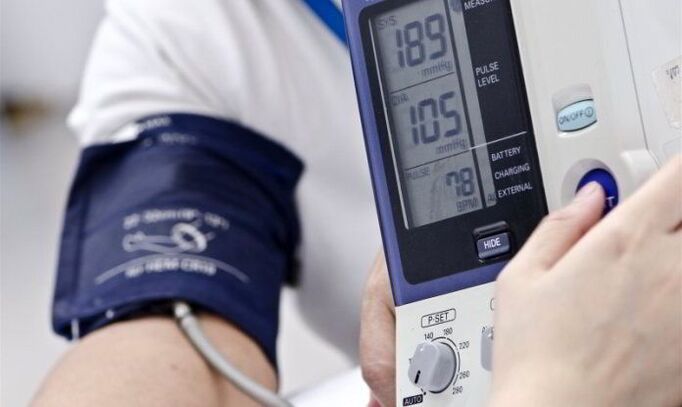Cervical osteochondrosis is a spinal disease, characterized by intervertebral disc disorders.Pathology is a characteristic of parents, but someone from any age can find it.Significant discomfort causes one of the main signs of the disease - severe pain.Patients need to know what is dangerous cervical osteochondrosis and what problems he or she will face.
Specific of disease
The cervical region is one of the most portable parts of the body, and it finds a common load.With the development of osteochondrosis, the transition of the vertebra, leading to compression of various vessels and nerves.The main complexity of the pathology is that the characteristics of the dystrophic feature affect the spinal cord and the intervertebral space disc.Therefore, the brain remains without the oxygen required, the blood supply is gone.

In the risk zone, there are mainly parents where the disease develops to the background of metabolic disorders, and changes in vertebral structure and intervertebral discs are associated.The reason for the development of these violations can also be:
- salt deposition;
- inadequate physical activity;
- Incorrect nutrition;
- injury;
- frequent hypothermia;
- Hormone problems;
- Overweight;
- Chronic diseases.
Osteochondrosis also creates a long body presence in one position, which puts office workers and drivers under the blow.
Symptoms of osteochondrosis
In the early stages of the disease, symptoms are almost invisible, anxiety can only cause mild pain in the neck.But as the pathology develops, the symptoms gradually increase.
Cervical spinal osteochondrosis can be identified by the following signs:
- severe pain in the neck, nape, shoulder;
- common migraine;
- Disadvantages of hand;
- Neck mobility is limited;
- When turning on the head, the vertebra is confused;
- Hearing problems;
- A feature ring appears in the ear;
- Discomfort in the throat.
In the early stages, the pain syndrome shows itself only during movement, when it tends to or the neck.Over time, pain occurs even when the position of the hand changes.
The possibility of complications
If cervical osteochondrosis is not treated, the degenerative process on the intervertebral disc will lead to loss of their main function and decrease in density.Excessive mobility of the spine will gradually develop, the muscles, joints and ligaments will suffer.Pressure at the nerves and spinal cord will only be intensified, which will lead to increased symptoms and development of new pathological phenomena.

Frequent migraines
To the most common consequences of cervical spinal osteochondrosis, you can count on headaches.This is because on this site that the vertebral artery is located, which is responsible for the delivery of oxygen and blood to the brain.
When the strength of the disc changes, the amortization function is violated.Press the defective vertebrae on the artery, interfering with blood circulation and "delivery" of oxygen required.Muscle cramps are developing.
Following the pain, the same symptoms are often followed:
- nausea;
- vomiting;
- increased pressure in pressure;
- tingling in the shoulder blade;
- Weaknesses throughout the body.
With severe attacks, it is advisable to rest as much as possible, preferably in a horizontal position.Unpleasant syndrome can produce painkillers or compress cold, while massage is useless.
Problems with vision
Cervical osteochondrosis complications often affect the organs of vision: in the spinal cord there is a drowsiness and vertebral arteries, which are responsible for blood flow to the visual central structure.Compression of the nerve roots and blood vessels lead to hypoxia and cause a decrease in vision.
Together with the vertebral artery syndrome, symptoms such as:
- fog;
- dark in the eyes;
- the appearance of "flies" or colored spots;
- bifurcation;
- excessive pressure on the optic nerve;
- dizzy;
- nausea.

During the examination, experts may see the narrowing of the retinal artery vessels, there is less frequent swelling of the optic nerve.Also, against the background of the disease, glaucoma may appear, accompanied by increased intraocular pressure and pain.
Hearing problems
Due to compression of the vertebral artery and nerve roots, hearing loss may be made by 20-30%.Cervical osteochondrosis neglected can lead to complete deafness.To avoid this, you must contact your doctor at the first symptom of the disease.
Little reduction in hearing can be reversed: in addition to the treatment prescribed by a doctor, the patient needs special training or ear shell massage.Watching TV or listening to music is better at small amounts to counteract the hearing organs.
Hypotension or hypertension
Reduced or increased blood pressure is a common result of cervical osteochondrosis.The biggest danger is hypertension, which is a feature:
- Ocomuation of the pulse;
- increased sensitivity to temperature;
- sleep disorders;
- nasal bleeding;
- Dyspnea;
- heart disease;
- Sweat.
The higher the blood pressure, the larger the burden falls in the heart, leading to the rapid clothing.As a result, heart failure develops.In hypertension, atherosclerosis develops faster, which is dangerous with brain stroke.
Hypotenia does not pose a direct threat to life, but it greatly affects its quality.The body is starving oxygen, which affects the general well -being of the patient.Hypotonia is characterized by infringement of venous and arterial blood supply, and this requires disruption in the sensitivity of the body.Among the possible complications is myocardial infarction.

Vegetables -vascular dystonia
Vegetables -vascular dystonia is a general naming of the syndrome, which can affect some of the body and organs.Most pathologies, the cardiovascular system and the peripheral nerves experience pathology.Patients experience persistent anxiety and sharp emotional differences.Frequent panic attacks are also possible, and heart rhythm is more frequent.
Symptoms of dystonia can be lubricated or consumed as other diseases.The result of osteochondrosis of the cervical area in this case is also not the most pleasant.Therefore, the gastrointestinal tract often suffers: nausea and vomiting, diarrhea, constipation and severe abdominal pain are possible.Gall bladder or liver possible.Patients often complain of tachycardia, stress problems and heart disease.
Intervertebral hernia
With intervertebral hernia, the disc fragments are "prominent" to the spinal cord or fall.The early stages of this pathology are called protrusion.The integrity of the intervertebral disc is not interrupted with it, but there is little bone highlights in the spinal cord.At this stage, the pressure on the spinal cord, so the main symptom is the weak pain that occurs during movement.In later stages, the pain syndrome is enhanced.
The vertebral mobility is gradually reduced.Muscle tension is enhanced, although the patient seems to be in a relaxed state.You can also notice periodic weaknesses on the upper hand or wrist.Hand stupidity arises, and tingling is often near the thumb.
This is a dangerous osteochondrosis of the cervical spine with hernia: it has a serious burden on the artery, which passes next to the vertebral column and is needed for proper blood supply to the brain.In the event of excessive patient pressure, ischemic stroke may be expected.
Large hernia is harmful to inflammation of the surrounding ligaments - this is full of cervical radiculitis.Only timely treatment can prevent complications.Patients should listen carefully and at the first symptoms to consult your doctor.Suspicions should cause:
- Sharp attacks of nausea for no apparent reason;
- dark in the eyes when moving;
- the noise in the ear while turning on the head;
- Attract a sensation around the neck with long accommodation in a standing position.
The most serious complication is the risk of paralysis that cannot be restored by one or both hands.Cerebral nerve atrophy leads to this, located in the cervical region.If the hernia begins to put pressure on the blood vessels, they will gradually die, which will lead to the preservation of several organs.
Barrel Vestibular Syndrome
Vestibular-Barel syndrome is a condition in which the patient has a strong dizziness that accompanies the loss of orientation.
Attacks arise with a sharp increase, quickly turning or throwing a head.FEATURES -State Features:
- noise in the ear;
- nausea;
- visual disorders;
- The feeling that everything was spinning and floating before his eyes.
The main cause of pathology is the lack of blood supply, which involves vestibular apparatus dysfunction.This syndrome will occur more and more often when osteochondrosis develops.
The glorious minute syndrome
Launched with harmful osteochondrosis with neuro-vascular disorders of the throat and larynx.This syndrome is characterized by:
- pain;
- difficulty when swallowing;
- continuous sensation of coma in the throat;
- dryness and pain;
- Losing a complete voice.
This syndrome occurs suddenly and is accompanied by dizziness.
Lieu Bar Syndrome
The second name of the pathology is the vertebral artery syndrome.The cause of its development is stenosis (narrowing) the vertebral tract, where the vertebral artery cramps and the compression of the blood vessels and nerves occur.
Symptoms include:
- hypertension;
- nausea;
- Tachycardia;
- carving in the eyes;
- noise in the ear;
- loss of movement coordination;
- The pain of pulsating in the temple or in the occipital region.
With sharp movements or changing the neck, the patient may lose consciousness.

Hypotolamic syndrome
At the same time, the hypothalamus experiences syndrome - part of the brain responsible for metabolism, stress, sleep, body temperature and emotional reaction.Functional disorders can be demonstrated by improving or weakening the activity of the brain department.In the first case, the patient becomes irritable, in second place.
Symptoms often resemble neurasthenia, which shows itself through:
- sleep disorders;
- hate;
- irritation;
- high fatigue;
- The absence of mood.
Someone loses the opportunity to concentrate, there is a problem with memorization.The outbreak of unreasonable anger is possible, the appetite is lost, Libido decreases.
It is best to prevent any disease from treating, to predict osteochondrosis behavior is quite difficult.In the event of a risk factor, you need to regularly do a simple set of physical exercises that will increase vertebral mobility and eliminate congestion in the collar area.
Frequent appearance from any of the symptoms described is a clear signal of the body about the problems that occur in it.At the same time, self -medication is useless, and without consulting a specialist it will not work.

















































